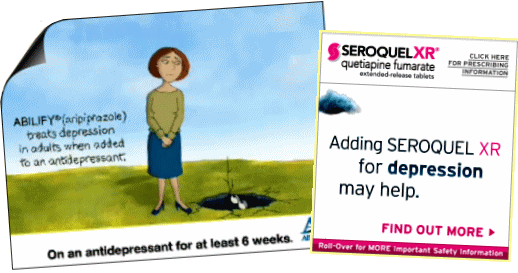So when I got on my current kick of looking into augmenting SSRI failures with Atypical Antipsychotics, in spite of my skepticism, I wondered "What mechanism they proposed?" and "Who thought up trying it the first time?" Usually, the answers to such questions just come up when I’m darting from article to article – but not this time. So I actually wrote some people. A few laughed and said, "Rationale? They don’t need a Rationale," one adding, "there were drugs to be sold!" Most simply said something like, "No clue." Nobody seemed to know.
by Charles B. Nemeroff, M.D., Ph.D.Journal of Clinical Psychiatry. 2005 66 [suppl 8].
Treatment options for bipolar depression and treatment-resistant unipolar depression include augmentation of antidepressant therapy with a nonantidepressant drug, including atypical antipsychotics. Risperidone is effective in combination with fluvoxamine, paroxetine, or citalopram in treatment-resistant unipolar depression, with reported remission rates of 61% to 76%. Olanzapine in combination with fluoxetine is safe and effective in patients with bipolar depression and those with fluoxetine-resistant unipolar depression. Ziprasidone and aripiprazole augmentation of various selective serotonin reuptake inhibitors has been reported to be effective in refractory unipolar depression in open-label studies. Data on use of quetiapine or clozapine as augmentation therapy for depression or anxiety are not yet available. Further double-blind, placebo-controlled studies of augmentation of antidepressants with atypical antipsychotics in refractory depression and anxiety are justified based on the available literature.
Support for investigation of atypical antipsychotics in patients with depression comes partly from preclinical studies suggesting that several atypical antipsychotics are potent 5-HT2A antagonists at low doses31–33 and may facilitate the action of serotonin at the 5-HT1A receptor, thereby augmenting the efficacy of SSRIs24…
by Robert B. Ostroff, M.D., and J. Craig Nelson, M.D.Journal of Clinical Psychiatry. 1999 60:256–259.
Background: At low doses, risperidone acts as a 5-HT 2 antagonist. Preclinical data suggest 5-HT 2 antagonists may enhance the action of serotonin. This report examines the clinical use of risperidone to augment selective serotonin reuptake inhibitor [SSRI] antidepressants in patients who have not responded to SSRI therapy.Method: In 8 patients with major depressive disorder without psychotic features [DSM-IV] who had not responded to an SSRI, risperidone was added to the ongoing SSRI treatment. Hamilton Rating Scale for Depression scores were obtained before and after the addition of risperidone.Results: These 8 patients remitted within 1 week of the addition of risperidone. Risperidone also appeared to have beneficial effects on sleep disturbance and sexual dysfunction.Conclusion: Risperidone may be a useful adjunct to SSRIs in the treatment of depression.
"The current article describes the use of risperidone as an augmentation strategy. Both preclinical and clinical data provide suggestive evidence that augmentation with risperidone might be effective in treating depression. Risperidone is an atypical antipsychotic, which, at low doses, is about 100 times more potent in antagonizing the 5-HT 2A receptor than the D 2 receptor. The 5-HT 2A receptor is an excitatory receptor that acts in opposition to the postsynaptic 5-HT 1A receptor; thus, antagonism of the 5-HT 2A may facilitate the action of serotonin at the 5-HT 1A receptor. This was demonstrated by a preclinical study [in rats, in 1985] which found that ketanserin, a 5-HT 2 antagonist, enhanced the inhibitory effects of serotonin on prefrontal neurons. This preclinical finding suggests that addition of a 5-HT 2 antagonist to a selective serotonin reuptake inhibitor [SSRI] might augment the effects of the SSRI."
by Lakoski JM, Aghajanian GK.Neuropharmacology. 1985 24:265–273.The ability of the putative serotonin2 [5-HT2] antagonist ketanserin, to alter serotonin [5-HT]-induced responses in cell firing was examined in the prefrontal cortex, the lateral geniculate nucleus and the dorsal raphe nucleus of the rat by microiontophoretic extracellular single unit recording techniques. In the prefrontal cortex, ketanserin failed to antagonize the inhibitory effects of 5-HT recorded in cerveau isolé or preparations anesthetized with chloral hydrate [pure excitatory responses to 5-HT were not observed in either of these preparations]. Paradoxically, the inhibitory response produced by 5-HT [but not gamma-aminobutyric acid, tryptamine or norepinephrine] was potentiated, even in cells where ketanserin alone did not alter spontaneous firing rates. The systemic administration of ketanserin [5 mg/kg, i.p.] had effects similar to those observed in the microiontophoretic experiments in the prefrontal cortex. In the dorsal raphe nucleus of animals anesthetized with chloral hydrate, ketanserin neither attenuated nor potentiated the inhibition of serotonergic neurons by 5-HT. In the lateral geniculate nucleus, as in the prefrontal cortex, ketanserin potentiated rather than attenuated, the inhibitory effect of 5-HT. Ketanserin was found to attenuate the excitatory responses produced by norepinephrine, an alpha 1-adrenoceptor-mediated response, in the lateral geniculate nucleus. The observed potentiation by ketanserin of inhibitory responses to 5-HT but not those of gamma-aminobutyric acid, tryptamine or norepinephrine, recorded in the prefrontal cortex, may be consistent with the proposed interaction between ketanserin and a specific 5-HT2 binding site.

George Aghajanian whom you cited from 1985 is a first rate, scientifically independent, neuropharmacologist. The inference by Nelson that what GA found might explain the so-called augmenting action of AAP drugs is just speculation.
Speaking of markets, notice the sly insertion of anxiety as well as depression in the Nemeroff piece. That’s the sort of thing ghost writers do.
The ghosts are out in force in the clinical papers posted here, including the ones in 2015. Obviously, disclosure has done nothing to curb the haunting…